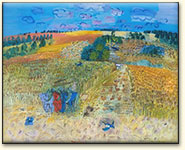Raoul Dufy's Ambient Light
Raoul Dufy experimented with color even before the first Fauve exhibition in 1905. He did not exhibit with Henri Matisse and his group of Fauves at the first show, but he was excited by their creative use of color and drawing. He develops his own theory of couleur-lumière, (heightened ambient color/light), which he uses throughout his career.
Explore the colors in the following painting to see how Dufy’s unique use of color affects your perception, and how other kinds of colorings transform the effect.
Jeanne with Flowers, Raoul Dufy, 1907. Recolored by Laura Joy Lustig, 2003.
Dufy, born in Le Havre in 1877, enrolls at the local arts school at the age of 15. There, he meets Georges Braque. In 1900, the town of Le Havre awards him a grant to study art in Paris. His interest in color begins with the Impressionists, and he admires works by Claude Monet and Camille Pissarro. Like Braque, Dufy’s hometown friend and fellow Fauve, Dufy experiments with Cubism begin in 1907, when he utilizes flattened space and an emphasis on form. Upon Dufy’s death in 1953, Matisse proclaims, “Dufy’s work will live.”
Dufy’s work as a designer, specifically for the couturier Poiret, should be noted. His decorative use of color revolutionized the picture surface. Dufy’s landscape, The Wheatfield (1929), ignores traditional ideas on aerial perspective, an innovation of the Renaissance developed by Venetians like Giovanni Bellini (c. 1430-1516) and Tiziano Vecelli, known as Titian (c. 1488-1576). Please see the exhibit on “Bellini’s Feast of the Gods” where the illustrations show how as objects recede, they become less distinct, less contrasted in tone, and bluer in hue due to the intervening distance and air. Painters strove to try and convey these effects, which were particularly noticeable in a city like Venice that was prone to mist from the surrounding water. Later, aerial perspective was perfected by the 17th century French painter Claude le Lorrain (1600-1682), and greatly admired by both JMW Turner and John Constable.
Dufy reversed aerial perspective: the bright colors used in the distance of The Wheatfield become a decorative pattern of colors. Yet upon stepping back, the spectator senses that Dufy sets up a tension between the surface of the canvas and the apparent “depth” (the three-dimensional illusion of depth). In other words, Dufy succeeds in leading our eye into the landscape while defying conventionally accepted methods of doing so. Artists such as Joan Miro (1893-1983) later followed Dufy’s example in some of their landscapes. Likewise, Impressionists such as Monet also convey to the observer that he or she is looking at an artist’s personal interpretation of a particular subject. (See entry on Impressionism).
